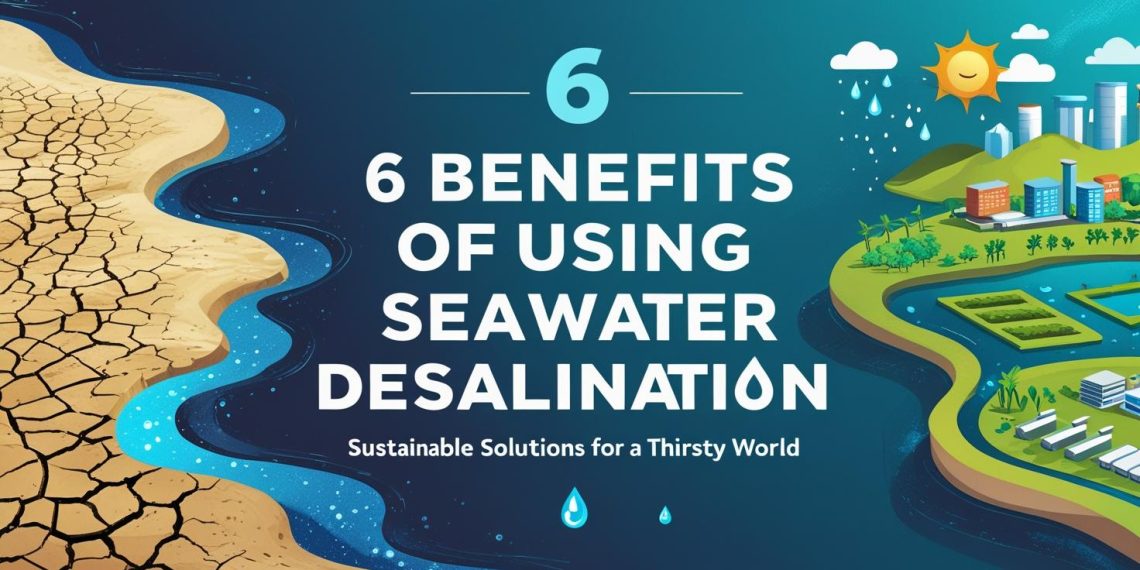Last updated on June 9th, 2025 at 03:22 pm
Water is an essential element for life on earth. So much so that with the increase in population over time water which is consumable is being used at a higher rate drastically depleting this resource. One of the major facts is that consumable water which is fresh water free of unwanted salts is available on the earth in very less amount. 97% of the earth is covered by seawater which is of no use to the life on land. Adding to this the problem of global warming, overpopulation, and depleted resources; the race is left with nothing but to search for alternate ways that can solve this problem. One such way is to use the seawater which is abundant, by filtering it to the standards of consumption. The process of converting seawater into fresh drinking water by removing unnecessary and harmful salts is known as Sea Water Desalination. This technology is not new and has been known to us for a long time now. It seems apt then to understand what are the advantages of this process.
In a world facing increasing freshwater scarcity, the demand for alternative water sources has never been more urgent. Sea water desalination has emerged as a vital technology to meet this challenge. By converting saltwater into clean, potable water, desalination not only ensures reliable water access but also supports a variety of industries, from agriculture to energy. Below, we explore the six most impactful benefits of using sea water desalination, highlighting how this process is transforming water sustainability worldwide.
- Abundant and Reliable Water Supply
With over 70% of the Earth’s surface covered in oceans, sea water represents the most abundant water source available. Unlike freshwater resources that are heavily reliant on rainfall, rivers, or groundwater levels, sea water offers a consistent and nearly inexhaustible supply.
Desalination plants can operate year-round, regardless of droughts, climate variability, or depleted aquifers. This reliability is especially crucial for arid regions and island nations where freshwater availability is minimal or seasonal. By tapping into this vast resource, communities and industries can enjoy long-term water security without depending solely on traditional water sources.
- Reduces Pressure on Freshwater Resources
Freshwater sources such as lakes, rivers, and groundwater reserves are under growing stress due to population growth, agricultural demands, and industrial use. Overexploitation of these sources often leads to ecological degradation, land subsidence, and reduced water quality.
By integrating desalinated sea water into the supply chain, the pressure on these natural resources can be substantially reduced. This allows freshwater ecosystems to recover, ensures sustainable groundwater levels, and supports the overall health of the environment. In many areas, desalination provides a necessary alternative water supply that enables planners to balance demand while preserving vital ecosystems.
- Enhances Water Security and Independence
Water security is a cornerstone of national resilience. Countries that depend on transboundary rivers or imported freshwater face significant geopolitical risks. Sea water desalination offers a path to independence, enabling nations to control their water supply without reliance on external agreements or unstable weather patterns.
Strategically located desalination facilities can be built near coastal urban centers, where population density and water demand are highest. With on-site production, municipalities reduce their vulnerability to supply disruptions, contamination, or sabotage, thereby enhancing infrastructure resilience and national security.
- Supports Economic Growth and Industrial Development
Industries such as oil and gas, power generation, chemical processing, mining, and food manufacturing require vast quantities of high-quality water. In many cases, conventional freshwater sources are either insufficient or non-existent near industrial zones. Desalination provides a reliable industrial water supply that meets strict quality standards.
Moreover, the desalination sector itself is an economic engine. It generates employment opportunities in engineering, construction, plant operations, logistics, and maintenance. As technology evolves and capital costs decrease, more regions are adopting desalination to attract investors, develop economic zones, and diversify water sources that support industrial expansion.
- Advances in Technology Improve Efficiency and Sustainability
Modern desalination processes, including reverse osmosis (RO) and multi-effect distillation (MED), have significantly improved in terms of energy efficiency and environmental impact. Innovations such as energy recovery devices, hybrid systems, and solar-powered desalination units are making it more feasible for regions to adopt this technology without excessive energy consumption or high operational costs.
Many plants today incorporate smart sensors, AI-driven process optimization, and sustainable brine management systems to minimize ecological impact. With continuous investment in research and development, the cost per gallon of desalinated water is steadily declining, making it a more cost-effective solution compared to expanding or transporting traditional water supplies.
- Emergency and Disaster Response Capability
In times of natural disasters, war, or infrastructure collapse, immediate access to clean drinking water is a top priority. Sea water desalination units, particularly mobile or containerized systems, are crucial in such situations. They can be rapidly deployed to coastal disaster zones, providing thousands of gallons of clean water per day for affected populations.
Desalination also plays a role in military operations and humanitarian missions, enabling self-sustaining water production in remote or resource-constrained areas. This capability is increasingly integrated into national emergency response strategies, reinforcing desalination as a critical component of disaster preparedness and resilience planning.
Conclusion: The Future of Desalination Is Now
The benefits of using sea water desalination are transformational, especially as the world faces growing water scarcity, environmental pressures, and unpredictable climate patterns. From supplying clean water to cities and industries to supporting national security and disaster relief, desalination offers a sustainable and scalable solution.
While challenges remain—particularly in energy use and brine disposal—technological advancements and global policy focus are propelling desalination forward. Countries and corporations that embrace this solution are not only investing in water sustainability, but also future-proofing their operations, ecosystems, and communities.
As demand for freshwater accelerates, sea water desalination is set to play an even greater role in securing the world’s most precious resource—clean, safe water for all.










Can you be more specific about the content of your article? After reading it, I still have some doubts. Hope you can help me.
Can you be more specific about the content of your article? After reading it, I still have some doubts. Hope you can help me.
I don’t think the title of your article matches the content lol. Just kidding, mainly because I had some doubts after reading the article.
Your article helped me a lot, is there any more related content? Thanks!